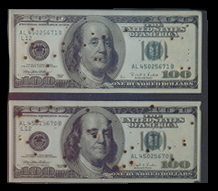

``Simulation threatens the difference between true and false; between real and imaginary.'' -- Baudrillard


Legal Tender (1996) was the first Internet telerobotic laboratory. Visitors to www.counterfeit.org were presented with a pair of US$100 bills, one real the other counterfeit. Users could perform experiments on the bills by registering with an email address. After receiving a password, the user was assigned a random sector on either bill A or B along with a magnified view of that sector:
Users were then invited to choose an experiment to perform on their sector.

Title 18, Section 333: Mutilation of National Bank Obligations:
``Whoever mutilates, cuts, defaces, disfigures, or perforates, or unites or cements together, or does any other thing to any bank bill ...shall be fined or imprisoned.''
After clicking "proceed", the results of the experiment were illustrated. Samples of the burn test are illustrated below:
|
|
Before |
After |

Bills after repeated experiments.
``The main point of Legal Tender is to heighten the uncertainties built into interactivity on the Web. Is a tele-robotic operation really carried out somewhere at your behest? Why is it necessary to ``register'' first? Is one's own engagement with this work its true telerobotic component? On what does anyone's credulity toward images and other information on the Internet rest?'' -- Kenneth Baker, 1996
``Why there is any aesthetic difference between a deceptive forgery and an original work challenges a basic premise on which the very functions of collector, museum, and art historian depend.'' -- Nelson Goodman, Languages of Art, 1976.